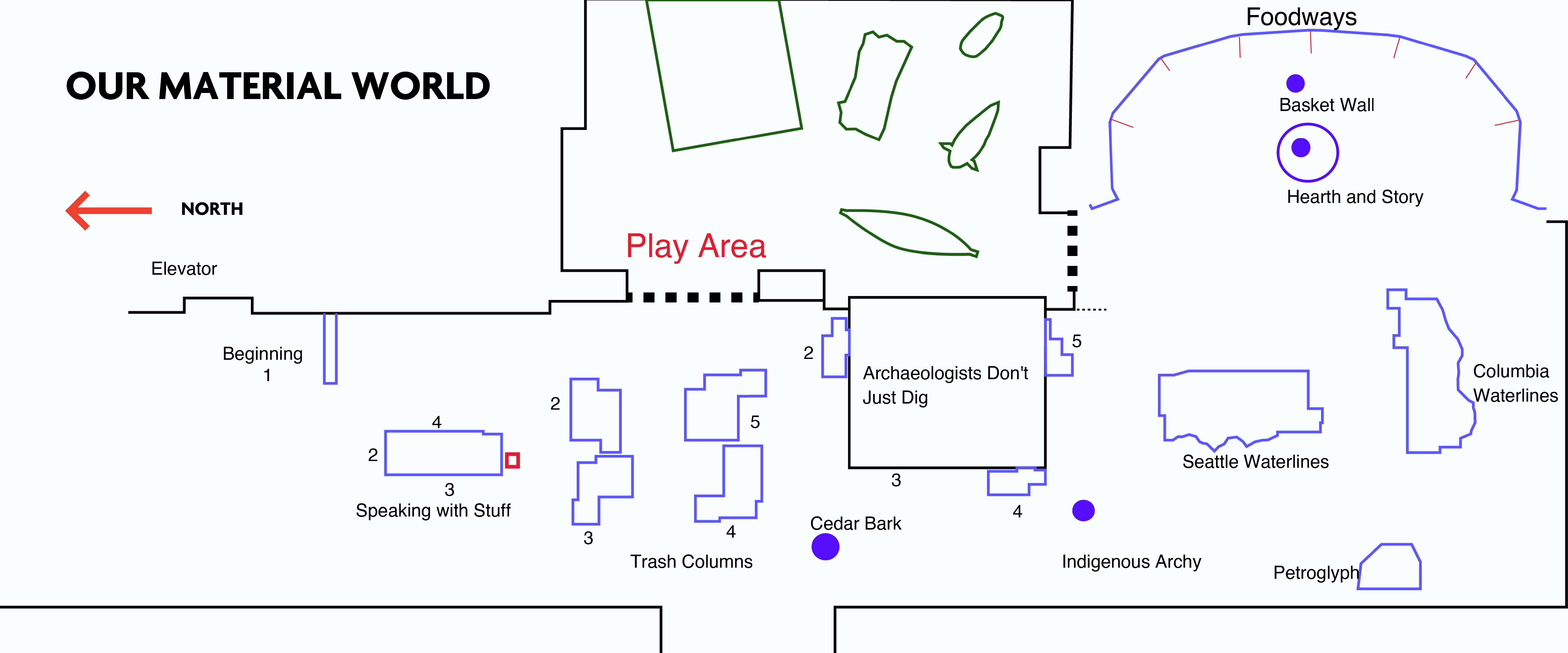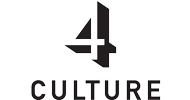Audio Guide
There are a few ways to find your way around the gallery. You can use the map above [also available in large print and tactile format], you can follow the signs or you can follow the markers on the floor. These markers are tactile and can be picked up with a cane. They mark the numbers and locations of each audio guide stop. The markers are located at the base of the display cases. For each audio recording below we include the number of ridges on the tactile markers for that stop. The map can also be used to help you find your way and includes reference to the tactile guide as well as the signage.
Widen the Frame
Listen to Lucinda Axtelle’s story to learn more about this project’s creation as a part of our Widen the Frame special installation.
Audio length: 2 minutes
Audio voice: Lucinda Axtelle
Beginning
Location: 3rd floor, to the left of the small elevator (closest to Admissions on first floor)
Tactile Marker: 1 ridge
Exhibit Label: Our Material World
Audio Length: 44 seconds
Audio Voice: Mary Jane Topash (Tulalip)
Speaking with Stuff:
Location: forward and to the right of the Welcome panel, middle of the gallery
Tactile Marker: This exhibit has four sides, the order is determined by the tactile markers. The first side has two ridges, the second side has three ridges, the third side has a footstool for the interactive display, and the last side has four ridges. The display is meant to be listened to/read counterclockwise.
Audio Length: 10 minutes
Audio Voice: Oliver Jue
Trash Columns
Location: behind the Speaking with Stuff display, start with the first left column
Tactile Marker: Like the previous exhibit this one has four sides and the order is marked with the number of ridges on the markers. Start with the first left column which is marked by two ridges, the second has three ridges, the third stop has four ridges, and the last stop has five ridges. Move counterclockwise, ending on the last left column.
Audio Length: 3 minutes
Audio Voice: Nuha Sabbah and Lucinda Axtelle
Cedar Bark Harvesting
This audio is from Mary Jane Topash (Tulalip) who describes her experience Cedar Bark Harvesting. We recommend you listen to it after the Trash columns and before Archaeologists Don’t Just Dig
Audio length: 4 minutes
Archaeologists Don’t Just Dig
Location: middle of the gallery around the railing/cedar tree display
Tactile Markers: This section also has four parts. The first is marked by a tactile with two ridges, the second has three ridges, the third has four ridges, and the fourth has five. This display starts right behind the last trash column on the left and also goes counterclockwise around the railing, which surrounds an opening between the floors.
Audio Length: 10 min total
Audio Voice: Aaron McCanna (Yup'ik)
Indigenous Archaeologist Voices: Aaron McCanna
We recommend you listen to Aaron’s story after finishing Archaeologists Don’t Just Dig before going on to the next display.
Audio length: 3 minutes
Petroglyph
Location: Far right wall of the gallery. If you are facing the last part of the archaeologists just don’t dig” display (facing the tree and the kids play area) turn left and head to the wall with the photos on it.
Tactile Markers: Turn left from the markers with five ridges and walk until you reach the wall. Then turn left and go along the wall until you run into the petroglyph rock.
Audio Length: 2 minutes
Audio Voice: Lucinda Axtelle and Justice McNeeley (Inupiaq)
Waterlines:
Location: From the petroglyph rock head to the left to the large Waterlines displays in the center of the back gallery.
Tactile Markers: From the petroglyph rock turn left and find the first Waterlines table. Feel the topography of the Seattle area and listen to the Seattle Waterlines audio.
Audio Length: Seattle Waterlines-12 minutes total, Celilo Waterlines-22 minutes total
Audio Voices: Seattle: Mary Jane Topash (Tulalip), Celilo: Polly Olsen (Yakama)
Hearth and Story
Location: If you walk between the two topographical displays you will arrive at the circular hearth.
Tactile: Go left between the two tactile displays until you reach the round back of the hearth, follow the circle to the seat and listen to the rest of the audio guide.
Audio Length: 3 minutes
Audio Voices: Justice McNeeley and Polly Olsen
Foodways:
Location: the Foodways wall is across from the hearth.
. The panels go in order from left to right.Tactile Markers: The foodways panels start to the left of the hearth and continue in a crescent formation along the wall.
The first audio is a story from Polly Olsen discussing the making of the basket wall. Then there is an audio playlist of the text on the wall by panel.
Basket Wall Audio: 5 minutes told by Polly Olsen
Foodways Audio: 21 minutes total read by Justice McNeeley
Archaeology Accessibility Kits
In addition to the audio guide, the Burke has two Archaeology Accessibility Kits which provide a touchable guide to the gallery for visitors who are blind, or have other sensory or learning difficulties. The kits are designed to be as easy to manage as possible for all of our patrons with physical disabilities. Though the kits do not need to be reserved in advance, we ask that you please only ask for the kit if it is something you need. We want to prioritize this experience for visitors with disabilities who cannot otherwise get the full Archaeology gallery experience. Alternatives exist for school groups or children. These kits are designed for users ages 12 and up. Ask a staff member at the admissions desk about checking out one of these kits.
The audio guide to the kits is provided below. The kits also include a large print and Braille version of this guide.
How can I use an Archaeology Accessibility Kit?
- If you would like to check out the Archaeology Accessibility Kit, go to the admissions desk and ask about accessibility options.
-
To return the kit, leave it in the box outside the Archaeology Workroom and ring the doorbell to alert staff that it has been returned.
-
If you are returning the kit on a weekend or holiday, alert a nearby volunteer or staff member that you have returned the kit to the box outside the Archaeology Workroom. Most often a volunteer or staff member will be in the Experience Alcove near the Paleontology Fossil Prep Lab.
Learn about the voices behind the audio
Lucinda Axtelle is a student at the University of Washington (class of 2023), studying anthropology and ethnomusicology. She helped create the kits, recorded and edited the audio, and facilitated the project at the Burke. She has been working as an archaeology assistant in the Burke since Winter 2022. Lucinda is visually impaired and has albinism.
Oliver Jue is an archaeology and art history student at the University of Washington. He currently works at the Burke Museum helping run the Archaeology Public Outreach Program, which aims to educate and invite the public into archaeology, as well as provide artifact identification.
Aaron McCanna is the DEAI/Decolonization Manager at the Burke Museum. His work centers on creating space for decolonial values to be explored in a good way, and building good reciprocal relationships in order to make those values practical. He is mixed race Yup'ik, Mexican, Irish and Scottish, and a graduate from Western Washington University with a BA in Anthropology and University of New Mexico with a MA in Public Archaeology.
Justice McNeeley is an Inupiaq woman and descendant of the Kaniqmiut people. She currently works at the Burke Museum as the Archaeology Repatriation Coordinator and the Assistant Registrar. She graduated in 2018 with a Bachelor's in Archaeology from UW, and is a 2022 UW Museology MA graduate. She centers her work on pursuing repatriation, decolonization, and healing for indigenous communities.
Adelyn McNew is a blind high school student who helped with the creation of this project. She worked on picking out items for the kits, helping write the scripts for the audio, and providing her skills in Braille. In addition Addy was a consultant for creating accurate audio guides. She interned at Burke over the summer through the YES-2 program. In her spare time Addy loves to travel and is a big animal lover.
Polly Olsen is a member of the Yakama Nation. She is the Director of Diversity, Equity, Access, Inclusion & Decolonization and the Tribal Liaison for the Burke Museum. Her work is focused enhancing reciprocal partnerships with tribes and communities. She is a UW graduate with a bachelors degree in Cultural Anthropology. Her work at the Burke Museum began in June 2017. Polly can be heard telling the story of Badger and Coyote as well as the story behind our basket wall, in the audio guide to the archaeology gallery.
Nuha Sabbah participated in the creation of this project, by helping with writing the scripts, being one of the narrators in the audio recordings, and picking out items for the kits. She is a visually impaired student in high school who interned at the Burke over the Summer through the YES-2 program. Some of her interests are learning about history and the past, art, and music.
Mary Jane Topash,Tulalip Tribes, is the Assistant Director of Cultural Education Initiatives at the Burke Museum. Her undergrad is in Anthropology and American Indian Studies and her graduate degree is in Cultural Studies Mary Jane has worked in informal education in the museum field for over 10 years, focusing on Coast Salish Tribal history. Her work focuses on decolonial practices, equity and inclusion, informal teaching, anti-stereotyping, and anti-appropriation.


